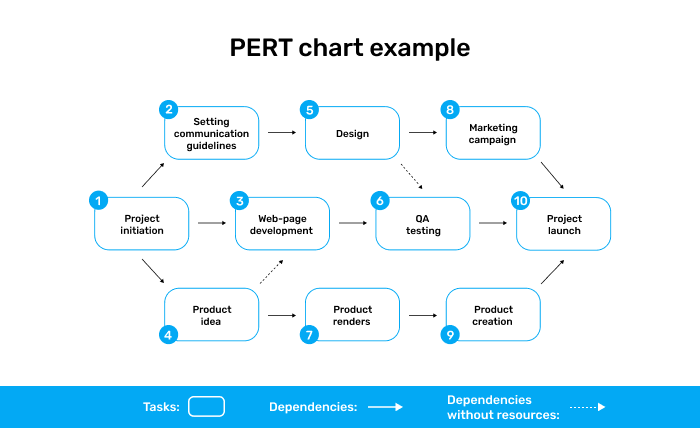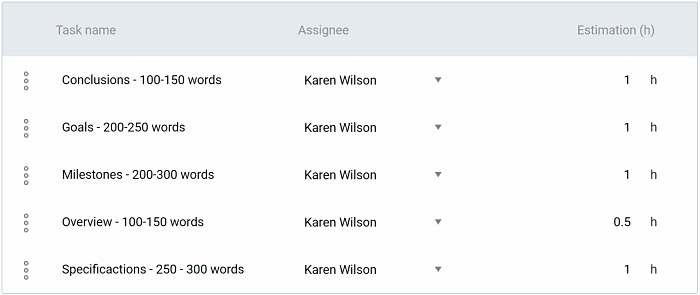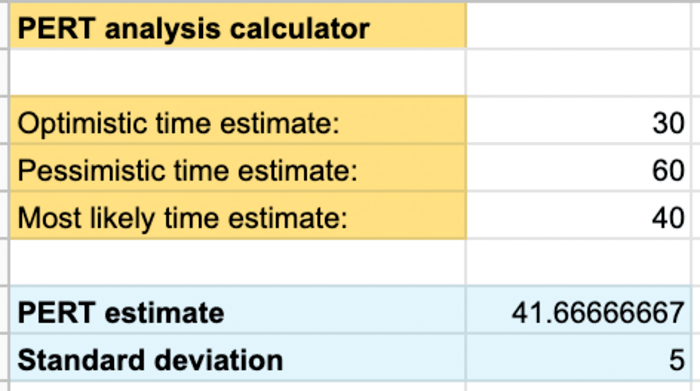The Ultimate Guide to Pert Analysis
Project management revolves around creating realistic project timelines. Successful project planning often relies on a statistical tool called Project Evaluation and Review Technique (PERT). Here's a free PERT calculator to help you plan your next project.

What is PERT chart?
Okay, so we've explained what the acronym actually means - but now let's discuss why people use this method.
In the official guide, PERT was defined as "a set of principles, methods, and techniques for effective planning of objective-oriented work thereby establishing a sound basis for effective scheduling, costing, controlling and replanning in the management of programs."
A division of the US navy called the Special Projects Office developed PERT in 1957.
Their intention was to create a structure that can depict the series of events within a certain period of time for the Polaris nuclear submarine project.
Due to the high level of the method's efficiency, in the following year, 1958, PERT was presented in the official summary report - and therefore made public.
Ever since, the method's popularity has been skyrocketing - as its metrics can be adapted to the most diverse types of demanding projects.
The total of 5 steps is required to create a PERT chart for a project:
- Identify all the tasks
- Determine task dependencies
- Connect the tasks
- Estimate time frames
- Manage the development and progress of the project
Why should you use a PERT calculator?
The simplified answer to why you should use this method is - you'll have answers to all the "what-if's" and be prepared to take action whatever happens.
More specifically, there are 3 main purposes of the PERT usage.
Let's explain each in more detail.
To better visualize the project timeline
For starters, it's a fact that 65% of people are visual learners and that's one of the main purposes of PERT charts - to create a visual representation of the project's timeline.
By doing so, project managers are breaking down complex issues into individual tasks.
That way, it makes it easier to schedule tasks, as well as establish what the dependencies are.
The order of dependencies helps project managers estimate all the potential risks and delays in order to get the end date for the worst-case scenario.
Moreover, the length of a project is always a necessary piece of information for developing a budget plan, as well as any other resources needed.
Let's take a look at a simple example - the supplier is late with the delivery of certain materials for construction. Naturally, workers on the site can't start working on that task, so the managers must find an alternative. If they don't want to cause further delays, they can appoint the workers to other tasks, which don't require said materials.
To better anticipate the actions in a project (and their impact)
What's also great about using PERT analysis is that you can do so before the project begins.
Complex projects usually require multiple tasks and activities to happen simultaneously, right?
Well, PERT will help you make sense of how each activity impacts others.
For example, think of what happens if there's a delay in the execution of a task, if its completion is needed for other activities.
This is something called task dependencies and means the following - don't use only the obvious delay into account when making the calculation.
The very word "dependency" implies that there is a specific order of activities. Meaning - one delay (for example, in the delivery of supplies) will affect all the succeeding activities, causing the butterfly effect and possible further delays.
To account for the uncertainty
A visual representation of task dependencies thus allows project managers to understand the risk of each separate delay of a task execution and the impact on a whole project.
That way, they can make a backup plan and develop several strategies for improving their performance and time management.
In order to be effective, project planning must include taking uncertainty into account - and further identifying the potential threats.
How does PERT work? How does the PERT calculator work?
The basis of the PERT's functionality relies on the 3 most important metrics - i.e., types of time estimates.
Those are:
- O - the most optimistic (the ideal version of a project execution, where everything goes right, with no delays in any part of the process)
- P - the most pessimistic (the worst-case scenario of a project execution, where everything goes wrong, and where every activity is delayed)
- M - the most likely to happen (the standard and expected duration of a project execution, taking most common threats and opportunities into account, based on previous experience)
The PERT formula takes all the above into account and goes as follows:
(O+4M+P)/6
Now let's take a look at this example of the metrics for a project execution, where O = 12 months, M = 14 months, and P = 18 months.
So the total would be (12+ 4*14 + 18) = 86, and we'll get the result once we divide the total by 6.
According to the PERT calculation, the time estimate for the project execution is 86/6 = 14.33 months.
What we can see from the formula is that there are 6 elements total and that the most likely scenario is counted 4 times.
On the other hand, the most optimistic and the most pessimistic scenarios are counted once each, due to the unlikeliness of them happening.
However, they might still happen - and that's the whole point of considering them.
We've been mentioning the project's execution, but here's another thing that makes PERT a valuable asset to project planning - project managers can use PERT for individual activities or tasks as well, and not just projects.
Tracking time for PERT metrics
Since all the relevant metrics revolve around duration, time tracking is vital during the process. Because, naturally, in order to evaluate something, you must measure it first. Timecards or timesheet templates are surely an option - but for complex projects, not an ideal one.
If you wonder why, the answer is simple - getting the actual report you need (gathering and presenting information from individual team members and projects) will be time-consuming.
Here's how timesheets look in Clockify, when automatically generated - based on the hours and minutes you track/enter.
Any report which isn't automatically generated won't be as precise, as the margin for human error will still exist. As you can see below, automatically generated reports have several other advantages, such as one-click sorting by:
- Specific users
- Teams
- Projects
- Dates
Learn more: Time tracking methods
What is "standard deviation" in PERT analysis?
Based on the metrics above, we can calculate another statistically relevant concept - standard deviation. It's a measure of the dispersement and points out how much your data is spread out from the mean value.
But what does it mean?
Standard deviation actually refers to the average deviation from time estimates. It points out how accurate your calculations are, and thus is very useful. The deviation can go both ways, depending on how well or badly the process goes. Meaning - the precise time can be either shorter or longer for the period of deviation.
The formula for calculating standard deviation goes as follows:
(P-O)/6
Basically, the smaller the result, the more accurate the estimation is.
Let's look at the previous example for this calculation as well - O = 12 months and P = 18 months.
The standard deviation calculation would go as follows: (18-12)/6 = 1 month.
We already established that the time estimate for the project execution is 14.33 months.
This time estimate for the project execution may "deviate" by 1 month - so, the project is likely to be finished anytime between 13.22 months and 15.22 months.
How to calculate the earliest expected time with PERT?
Let's check out how the PERT method works and the way it helps project managers estimate the most optimistic duration. The process can vary depending on the complexity of a project, but the core always stays the same.
PERT is based on a 3-point estimate we've explained and the visual representation helps us grasp the order in a chain of activities.
The first point is the most optimistic case, so how do you calculate it?
It's not exactly rocket science - but individual team members need to give accurate estimates on the duration of tasks.

The more precise the time given for each task is, the more accurate results of PERT will be. This is why time tracking in the projection is critical.
How to calculate the latest possible time with PERT?
On the other hand, the critical path represents the opposite of what we talked about in the previous segment. It's the most pessimistic, the longest sequence of time for a project's execution.
Imagine your project involves 5 different suppliers and you're expecting all of them to deliver on time and on the same day.
Yet, they are all late. As a consequence, other teams can't perform their jobs, as they need the supplies. Therefore, many planned activities will be on hold until the supplies deliver their part. That period should also be included into projection, even though there are no activities or tasks performed.
Calculating the critical path means taking every possible delay into consideration. And, as you should know, adequately estimating the time required can save you money.
Furthermore, not delivering your projects on time is not only a waste of time and money but can also seriously damage your reputation.
Example of using the PERT formula in project management
Let us show you how the PERT formula looks like in an example. For this purpose, we will use an imaginary project that is quite simple and has only one activity.
Let's say that you need to get from point A to point B.
The most optimistic estimation - according to the mileage in distance, the earliest possible time to arrive at point B is if you go by the shortest possible route, if the traffic is light, and you hit green on every traffic light.
We'll say it's 30 minutes.
The most pessimistic estimation — according to the mileage in distance, the latest possible time to arrive at point B is if you go by the longest possible route due to construction work on others, if the traffic is heavy for the same reason, and you hit red on every traffic light.
We'll say it's 1 hour.
The most likely to happen estimation — according to the mileage in distance and your previous experience driving the usual route, at that point of the day there won't be much traffic, but there will be several red lights on your way.
We'll say it takes you 40 minutes to arrive at your destination.
Now that we have the relevant information, let's crunch the numbers.

According to the results, the estimate (the mean value) is that it will take 41.6 minutes (rounded value) to reach your destination.
Standard deviation value implies that time may be up to 5 minutes shorter or longer, depending on the surrounding elements, such as traffic.
Now imagine being able to have a similar estimation for complex projects.
Sounds great, right?
PERT calculation - Example on a small project
Since the main purpose of the PERT analysis is to help project managers solve complex issues, let us use a slightly more complicated example.
It's a small project with several activities, each having their own predecessors and dependencies.
Let us provide an example. Say that we have to execute a landscaping project in our front yard. For the completion, there are 13 required activities total. In accordance with the predecessors and dependencies, the list of activities and time estimates (in hours) for our imaginary project would look like this:
| Activity number | Activity description | Optimistic estimation (hours) | Most likely to happen (hours) | Pessimistic estimation (hours) | PERT calculation (hours) (O+4M+P)/6 |
Standard deviation (hours) (P-O)/6 |
Time to complete (hours) |
|---|---|---|---|---|---|---|---|
| 1. | Mobilize | 12 | 24 | 48 | (12+4X24 +48)/6 = 26 | (48-12)/6 = 6 | 20–32 |
| 2. | Preparation of space | 24 | 72 | 120 | (24+4X72 +48)/6 = 60 | (120-24)/6 = 16 | 44–76 |
| 3. | Fence alignment | 12 | 24 | 72 | (12+4X24 +72)/6 = 30 | (72-12)/6 = 10 | 20–40 |
| 4. | Deliver posts to site | 48 | 72 | 144 | (48+4X72 +144)/6 = 80 | (144-48)/6 = 16 | 64–96 |
| 5. | Drill holes for posts | 120 | 168 | 240 | (120+4X168 +240)/6 = 172 | (240-120)/6 = 20 | 152–192 |
| 6. | Insert posts | 120 | 168 | 240 | (120+4X168 +240)/6 = 172 | (240-120)/6 = 20 | 152–192 |
| 7. | Backfill posts | 168 | 240 | 336 | (168+4X240 +336)/6 = 244 | (336-168)/6 = 28 | 216–272 |
| 8. | Deliver boards for fence | 24 | 72 | 168 | (24+4X72 +168)/6 = 80 | (168-24)/6 = 24 | 56–104 |
| 9. | Install boards | 72 | 120 | 192 | (72+4X120 +192)/6 = 124 | (192-72)/6 = 20 | 104–144 |
| 10. | Paint boards | 240 | 288 | 360 | (240+4X288 +360)/6 = 292 | (360-240)/6 = 20 | 272–312 |
| 11. | Plant shrubs along the whole length of the fence | 96 | 144 | 192 | (96+4X144 +192)/6 = 144 | (192-96)/6 = 16 | 128–160 |
| 12. | Inspection | 72 | 96 | 168 | (71+4X96 +168)/6 = 104 | (168-72)/6 = 16 | 88–120 |
| 13. | Demobilize | 12 | 24 | 48 | (12+4X24 +48)/6 = 26 | (48-12)/6 = 6 | 20–32 |
Once you list and estimate the length of each activity, you'll be able to get a total project duration estimate, in all three cases - optimistic, most likely to happen, and pessimistic.
You'll use the total to crunch the numbers and get your PERT estimate and standard deviation.
And since we've provided the calculator above, you won't actually have to use the formula and do the crunching yourself.
What we can conclude from the table above, according to the PERT calculation, the time to complete all the activities for this particular project will be in the range between 1,337 and 1,772 hours.
PERT analysis summary
As we are all familiar with, life is filled with uncertainties. No matter how thoroughly we plan our schedule, many things can happen to disrupt it. Therefore, we always strive to be prepared the best we can.
And that's exactly the point of PERT analysis - to help project managers eliminate, or at least minimize the uncertainty.
The visual representation of the project's timeline, including activities and task dependencies, will help you achieve your goals and objectives.
To get the best results and be able to deliver complex projects on time, it's vital to combine PERT with a time tracking method of your preference.
With a free software solution such as Clockify, you'll be able to:
- Get the most accurate time results
- Track progress by separate projects
- Track the expenses
- Track teams
References
- Bradford, W. C. (2011, September 1). Reaching the Visual Learner: Teaching Property Through Art. SSRN. https://papers.ssrn.com/sol3/papers.cfm?abstract_id=587201
- Derzap, S. (2021, May 21). Tips For Project Management, Navigating Risk And Achieving Your Goals. Forbes. https://www.forbes.com/sites/forbesbusinesscouncil/2021/05/21/six-tips-for-project-management-navigating-risk-and-achieving-your-goals/
- Moavenzadeh, F. M. (2009). Project Uncertainty Project Uncertainty Management Management [Slides]. MIT.Edu. https://ocw.mit.edu/courses/civil-and-environmental-engineering/1-040-project-management-spring-2009/lecture-notes/MIT1_040s09_lec24.pdf
- Oral History | Polaris Program. (2018, September 19). U.S. Naval Institute. https://www.usni.org/press/oral-histories/polaris-program
- PERT Program Evaluation Research Task Summary Report, Phase 1. (1958, July). Google Books. https://books.google.rs/books?id=22lNAQAAMAAJ&pg=PP3&lpg=PP3&dq=Program+Evaluation+Research+Task+(PERT)+Summary+Report
- Standard Deviation. (2021, April 15). Investopedia. https://www.investopedia.com/terms/s/standarddeviation.asp